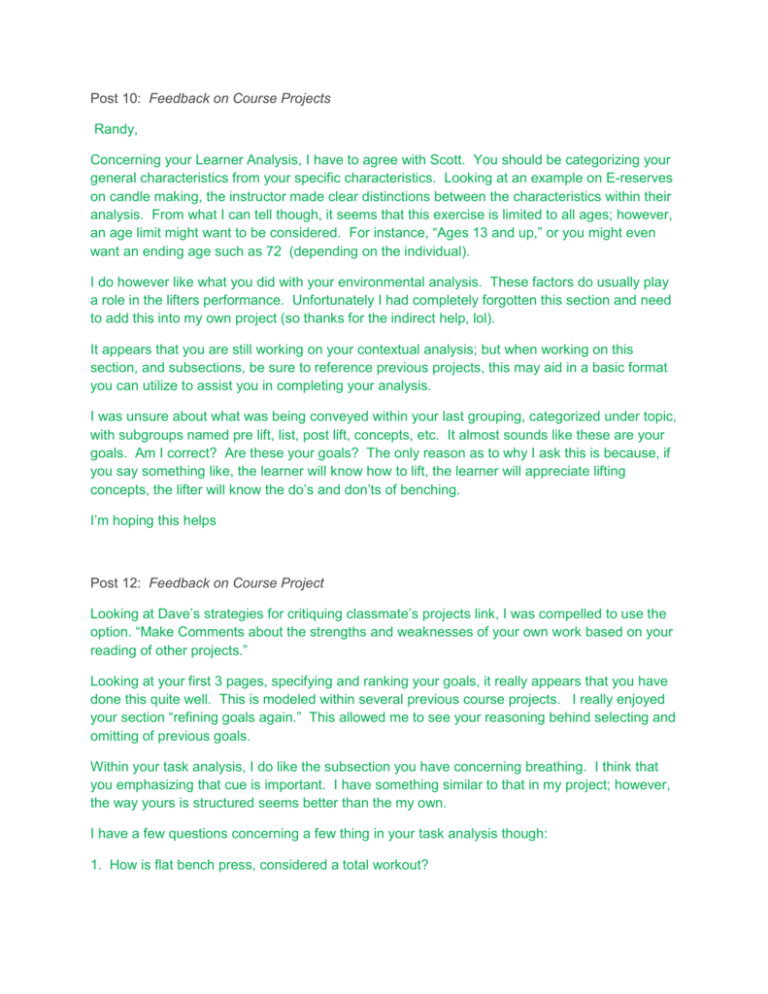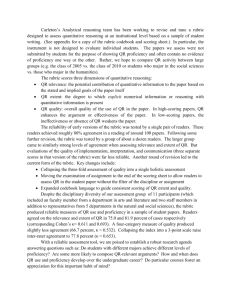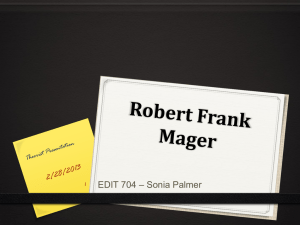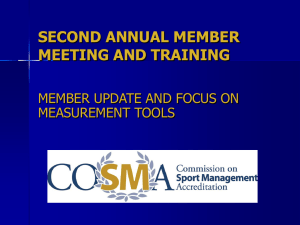Jury - Program Goal 4 (IT 510 Course Project)
advertisement

Post 10: Feedback on Course Projects Randy, Concerning your Learner Analysis, I have to agree with Scott. You should be categorizing your general characteristics from your specific characteristics. Looking at an example on E-reserves on candle making, the instructor made clear distinctions between the characteristics within their analysis. From what I can tell though, it seems that this exercise is limited to all ages; however, an age limit might want to be considered. For instance, “Ages 13 and up,” or you might even want an ending age such as 72 (depending on the individual). I do however like what you did with your environmental analysis. These factors do usually play a role in the lifters performance. Unfortunately I had completely forgotten this section and need to add this into my own project (so thanks for the indirect help, lol). It appears that you are still working on your contextual analysis; but when working on this section, and subsections, be sure to reference previous projects, this may aid in a basic format you can utilize to assist you in completing your analysis. I was unsure about what was being conveyed within your last grouping, categorized under topic, with subgroups named pre lift, list, post lift, concepts, etc. It almost sounds like these are your goals. Am I correct? Are these your goals? The only reason as to why I ask this is because, if you say something like, the learner will know how to lift, the learner will appreciate lifting concepts, the lifter will know the do’s and don’ts of benching. I’m hoping this helps Post 12: Feedback on Course Project Looking at Dave’s strategies for critiquing classmate’s projects link, I was compelled to use the option. “Make Comments about the strengths and weaknesses of your own work based on your reading of other projects.” Looking at your first 3 pages, specifying and ranking your goals, it really appears that you have done this quite well. This is modeled within several previous course projects. I really enjoyed your section “refining goals again.” This allowed me to see your reasoning behind selecting and omitting of previous goals. Within your task analysis, I do like the subsection you have concerning breathing. I think that you emphasizing that cue is important. I have something similar to that in my project; however, the way yours is structured seems better than the my own. I have a few questions concerning a few thing in your task analysis though: 1. How is flat bench press, considered a total workout? a. Isn’t this more of an isolated exercise? 2. I see in iii.A.3, in your task analysis, that you mention wearing gloves. Do you think that an overview of possible materials could fall into a category of its own? a. For instance, within mine, and also within the project instructing candle making, a list of materials is used to allow the learner to realize what all can be used for the task at hand. 1. I noticed that when I really looked at possible items incorporated within my topic, that another subsection could be implemented. 2. I feel that adding this subsection strengthened my project. Also, concerning bench pressing, you might want to ask your SME whether materials such as wrist wraps, weight belts, boards, or even chains are used. Post 16: Feedback on Course Project Ok, I've fixed one here. Could someone take another one of her 100% accuracies that doesn't quite work and revise it? Does anyone see that I'm also referring to your project? Could you offer an example to us from other projects of this same "problem"? Objective 2.2 After reading a short description of a junction box, learners will explain the purpose of a junction box with 100% accuracy. Ignorant to the purpose or benefits of a junction box, I am not sure whether or not this proficiency level should be this high. Dave emphasizes that 100% accuracy should be used when concerning life or death issues; however, this does not seem too fatal. Perhaps the proficiency level could be adjusted to 85 or 90%. Even though this does not portray an absolute understanding or mastery of a junction box, it still offers a high enough level of comprehension/understanding concerning this issue. Also, if you truly want the learner to gain a better understanding of a junction box (just my opinion), you might even want to consider having the learner paraphrase the importance of a junction box, rather than choosing between a listing of items. From the list of five items, circle two that accurately state why we use junction boxes. Within my objective: Objective 1.1 Given 20 images of good and poor conditioned materials, the learner will identify the good conditioned materials at 90% accuracy I made this mistake quite a few times within my instruction. For tasks that were elementary or knowledge based, I tended to set high proficiency levels on subjects/tasks that were not detrimental to one’s health. This is going to be something I intend on revising, followed by other things. Post 17: Feedback on Course Project Julie, Even though this is not the primary focus of this checkpoint, you may want to extend on your problem identification section. Within the rubric, it states in order to receive full credit for the section, the section must: 1. Identified appropriate method 2. describes process 3. correct implementation 4. Provide thorough analysis Your ranking of goals, contextual analysis, as well as your task analysis looks great! Concerning the goals and objective segment of your project, it is probably safe to say that your goals are properly defined, “stating the word know, value, or appreciate.” However, concerning your objectives, the objectives are not demonstrating a Mager objective. Mager objectives are supposed to contain: 1. Conditions of environment 2. Behavioral Verb 3. Proficiency level Within your documentation, none of your objectives contain a proficiency level. Stated within the rubric, Each objective is a complete Mager objective (including measureable verb, relevant conditions, and appropriate criteria) OR Gronlund objective (including clearly stated general objective and appropriate descriptors); objectives clearly address goals Reviewing your labeling, linking the task analysis to your objectives, as well as the classification of your performance, this section appeared to be pretty accurate. Regarding your generative strategy section, it would appear that a step was overlooked. Within the rubric, it states: 1. Appropriate strategies are designed for each objective with strong and clear documentation of prescription type 2. content-referenced explanation of initial presentation and generative strategy The prescription in which you chose to use within each objective, was not mentioned/stated. Pertaining to your writing of test items, you did an excellent job matching your test item to the objective. I hope this feedback is helpful. Post 18: Feedback on Course Project Randy, Let me start by saying, the goals that you used, are labeled correctly, and I am able to understand what is to be achieved through this goal. Great job. Concerning your objectives however, it would appear that none of your objectives are Mager objectives. 1. Conditions of the environment 2. Behavioral verb 3. Proficiency level Lacking a proficiency level, your objectives are not meeting the rubrics criteria, reverencing full points within this section. Within the rubric it states, Each objective is a complete Mager objective (including measureable verb, relevant conditions, and appropriate criteria) OR Gronlund objective (including clearly stated general objective and appropriate descriptors); objectives clearly address goals 1. Within test item 1.2, 2.1, 2.2, I see that you listed your proficiency level within your test item, you more so than likely should move this within your objective section. Your objectives appear to be classified correctly, regarding the matrix; however, I do not see where your objectives refer to your task analysis. Within the rubric, it also states, “All objectives are correctly referenced to the content/task analysis.” Pertaining to your test item matching your objectives, this appears to be done quite well; however, be careful when writing your generative strategies. The reason as to why I’m saying be careful within generative strategy 1.1, your strategy is matching the test item. Concerning your sequencing strategy, I understand why you selected what you selected; however, you should be more thorough in how you came to that conclusion. After all , within the rubric it states to select appropriate sequencing and provide thorough documentation. Applying to your preinstructional strategy as well, your Strategy must be appropriate and supported by substantial rationale for selection. I hope this helps.







